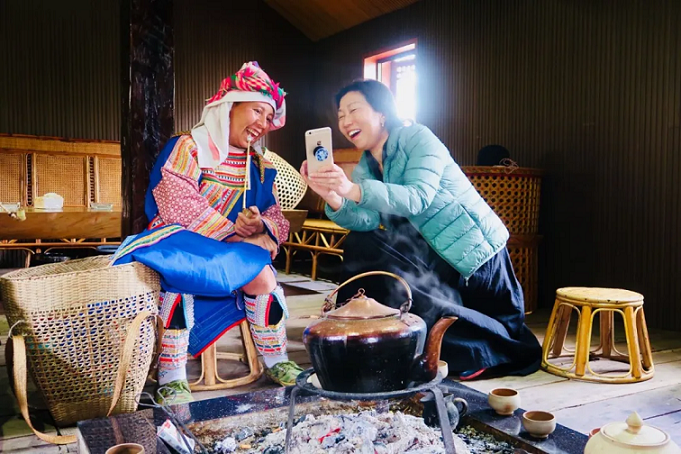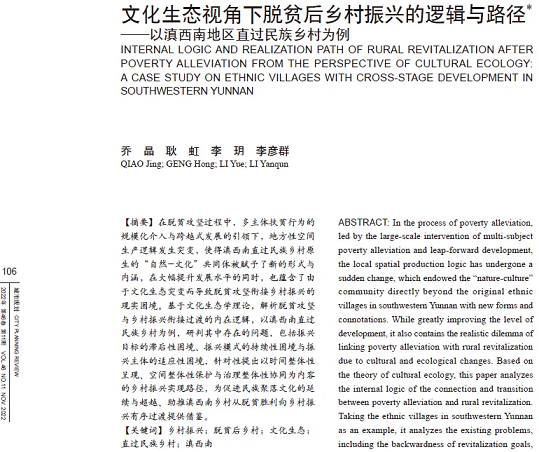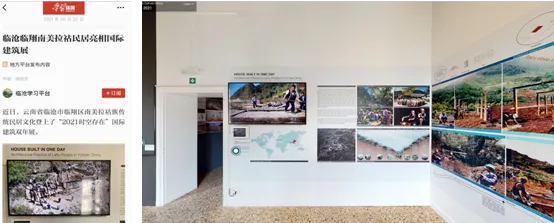


Introduction
From 2016 to 2022, Geng Hong, member of UPSC and Professor of the School of Architecture and Urban Planning at Huazhong University of Science and Technology (HUST), formed and led the "Joint work team on targeted poverty alleviation at Linxiang, Yunnan" along with her colleagues, providing continuous support to the Lahu ethnic villages. As early as 2019, UPSC had taken an interest in this work aimed at aiding intangible cultural heritage for poverty alleviation and promoting the designation of Lahu villages for protection.
Cultural confidence is the most fundamental, profound, and enduring power in the development of a country or a nation. From poverty alleviation to rural revitalization, the ecological wisdom of the coexistence with nature, the spatial fabric closely integrated with the environment, and the orally transmitted ancestral stories and age-old customs accumulated by ethnic villages over a long evolutionary process, are special factors that should not be ignored in their contemporary development, regardless of how rural living environments change or how production pattern evolve. These elements infuse rural revitalization with a vibrant and unique regional and cultural soul.
From 2016 to 2022, Geng Hong, member of UPSC and Professor of the School of Architecture and Urban Planning at HUST, formed and led the "Joint work team on targeted poverty alleviation at Linxiang, Yunnan". In the five years, they continuously engaged with the Lahu ethnic villages, uncovering, documenting, and archiving the unique forms and cultural and historical value of Lahu residential construction culture. They restored and refined the "Lahu Wooden Palm House Construction Techniques" comprehensively and systematically for the first time with their professional knowledge and technical methods, and assisted the local government in successfully applying for inclusion in the fifth batch of the provincial intangible cultural heritage representative project lists of Yunnan Province in December 2022. This marked the first time that a traditional craft from Lincang City was selected for the provincial intangible cultural heritage list.
Authentic Culture, Simple Craftsmanship, and the Endangered Continuity in Development
The Lahu Wooden Palm House, locally known as "Zhapianfang," is an example of early southern Chinese stilt-style architecture that remains alive today. It features the typical "eaves post and fork post" and "binding and tying" constructions at a low technological level. The Lahu people's unique ritual of "building a house in one day" is even more peculiar. From sunrise to sunset, this process involves seasonal material preparation throughout the year, gender-based division of labor ("men fetch wood, women fetch speargrass"), and an organizational system where "one family builds a house, the entire village helps." The construction of the Lahu Wooden Palm House is completed in a day amidst mysterious rituals of exorcism, blessings, and the lighting of the hearth.
The Lahu people are a minority without a written language, preserving their culture solely through oral transmission. Although the Wooden Palm House was recognized as a representative project in the first batch of municipal intangible cultural heritage in 2005, the construction techniques, the system of inheritors, and the unique genealogical value of its construction culture have yet to be systematically documented in text and images. Moreover, there is a lack of professional technical analysis, skill restoration, and modern video recordings. This creates substantial safety risks for the long-term protection and transmission of their authentic culture.
Mission Commitment and Professional Dedication: Discovery and Protection in Assistance
To this end, Professor Geng Hong, together with multidisciplinary experts in urban and rural planning, architecture, art design, and sociology, applied their keen professional insights and sense of responsibility to thoroughly analyze the invaluable role of the Lahu Wooden Palm House construction techniques in the preservation of ethnic culture and fostering rural revitalization. They anticipated the survival crises, protection risks, and inheritance difficulties that might arise or had already emerged on the path from poverty alleviation to common prosperity in urban and rural areas. With the full understanding, support, and cooperation of the local government, they overcame challenges such as poor transportation, language barriers, and lack of resources. Over the past five years, through oral interviews and field surveys with dozens of intangible cultural heritage inheritors, they have produced hundreds of hand-drawn sketches of Wooden Palm Houses and reports with hundreds of thousands of words.
By employing professional processing and video documentation, they completed the initial digital restoration of the Wooden Palm House and documented the entire process of the distinctive "building a house in one day" ceremony. They also assisted the local government in promoting and completing the designated protection of 3 traditional villages, 28 traditional Wooden Palm Houses, and the registration of 9 ethnic construction technique inheritors. With these efforts, they developed a systematic content framework titled "Lahu Residential Construction Culture and Ecological Wisdom."


Photos of on-scene works


Hand-Drawn Records and Digital Restoration of Wooden Palm Houses
Support from UPSC to lay the Practical Foundation, and Value Transformation in Action
As early as 2019, UPSC took an interest in this beneficial work aimed at aiding intangible cultural heritage for poverty alleviation and promoting the designation of Lahu villages for protection. Based on UPSC, the team has been researching and promoting its value, including the journal “Urban Planning” published by UPSC and various academic conferences hosted by UPSC. These platforms have showcased the team's professional insights and systematic summaries regarding the construction culture of the Lahu.
Today, the "Lahu Wooden Palm House Construction Culture" project has become a significant cultural symbol of rural revitalization and a traditional display at major festivals. The team has fully leveraged the authenticity and local characteristics of the Lahu construction culture to create the innovative "Lahu Straight-through Ethnic Cultural Ecological Protection Zone." They proposed an integrated working mechanism of "Authentic Cultural Protection - Pan-Museum General Design - Cultural and Tourism Industry Integration Activation," achieving the local transmission and dynamic utilization of ethnic culture, and generating significant economic and social benefits.
According to the latest data, in 2023, the popularity of the "Lahu Style Park" continued to rise, with the number of tourists reaching a record high of
210,000. Thirty percent of tourists stayed in the "new Wooden Palm Houses," generating tourism revenue of 1.6 million yuan, thereby providing reliable confidence and motivation for subsequent ethnic cultural and environmental construction. More importantly, villagers have become more open to the understanding and appreciation of the traditional Wooden Palm Houses handed down from their ancestors. Many villagers have begun to adopt the Wooden Palm House style in constructing new homes, aided by modern building techniques. The positive protection efforts have brought tangible benefits and fostered a conscious awareness of cultural preservation and an intrinsic pursuit of environmental improvement.
In 2021, during the pandemic, the Lahu Construction Culture project was invited by the European Cultural Center to participate in the 18th Venice International Architecture Biennale, attracting 420,000 international visitors both online and offline. The "Building a House in One Day" ceremony showcased the world the story of the Lahu Wooden Palm Houses and conveyed the ideals of ethnic harmony, cultural co-construction, and shared achievements in China.

Promoting and Advocating for the Lahu Construction Culture and Its Contemporary Value in “Urban Planning” and Annual Conferences

The Lahu Construction Culture Exhibited at the 2021 Venice International Architecture Biennale
Persistent Tracking, Unremitting Progress, and On-going Innovation while Renewing the Old
Local culture and ethnic regional culture are rooted in specific historical, social, natural, and ecological contexts. While their value recognition and scientific protection rely on external support, the long-term vitality cannot be achieved solely through mechanical demarcation and spatial restoration. In the past two years, Professor Geng Hong's team has continued to periodically monitor the development of various construction projects in Nanmei Township. They have particularly focused on the "Lahu Style Park" and the "Bridge Park" pan-museum project, which is based on the Lahu New Year ceremony "Bridge Festival." The team maintains continuous contact with the township government and the local cultural station, staying informed about developments and providing recommendations.
The support team continues to move forward, expanding from theoretical research to practical innovation. They are exploring ways to integrate traditional construction cultural resources into rural revitalization mechanisms and creating unique and powerful pathways. Their efforts extend from the Lahu villages in Nanmei to the Dai villages in Mengwang. The team has also united more young talents, contributing to the planning, protection of ethnic culture, and rural revitalization, much like the ever-burning hearth in the ancestral homes of the Lahu people, representing continuous life and vitality.
Author:Qiao Jing、Geng Hong
Source: <https://mp.weixin.qq.com/s/1vdVih6ugY9Y6PR8T0mWOQ>
Translated by He Huiling